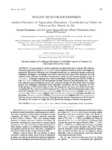Por favor, use este identificador para citar o enlazar este ítem:
http://www.alice.cnptia.embrapa.br/alice/handle/doc/864082Registro completo de metadatos
| Campo DC | Valor | Lengua/Idioma |
|---|---|---|
| dc.contributor.author | RINGENBERG, R. | pt_BR |
| dc.contributor.author | LOPES, J. R. S. | pt_BR |
| dc.contributor.author | BOTTON, M. | pt_BR |
| dc.contributor.author | AZEVEDO-FILHO, W. S. de | pt_BR |
| dc.contributor.author | CAVICHIOLI, R. | pt_BR |
| dc.date.accessioned | 2011-07-08T11:59:01Z | - |
| dc.date.available | 2011-07-08T11:59:01Z | - |
| dc.date.created | 2010-10-13 | pt_BR |
| dc.date.issued | 2010 | pt_BR |
| dc.identifier.citation | Neotropical Entomology, Londrina, v.39 n.2, p. 187-193, 2010. | pt_BR |
| dc.identifier.uri | http://www.alice.cnptia.embrapa.br/alice/handle/doc/864082 | pt_BR |
| dc.description | In some American countries, grapevines are affected by Pierce?s disease (PD), which is caused by a particular strain of Xylella fastidiosa not yet reported in Brazil. In order to investigate the potential for PD spread in Brazil in case of pathogen introduction, we conducted a faunistic analysis of leafhoppers (Hemiptera: Cicadellidae) associated to vineyards in the State of Rio Grande do Sul, with emphasis in the subfamily Cicadellinae (sharpshooters), which includes the main potential vectors of X. fastidiosa. Leafhopper samplings were carried out fortnightly during two years (9/2004-9/2006) in four Vitis vinifera vineyards in the municipalities of Bento Gonçalves and Farroupilha (RS). Thirtyfour leafhopper and six spittlebug species were collected, but most (98.4%) of the 3,893 specimens trapped were leafhoppers, distributed in the subfamilies Cicadellinae (60.2%), Gyponinae (34.1%), Deltocephalinae (3.8%) and Coelidinae (0.3%). The sharpshooter specimens were divided in the tribes Cicadellini (68.5%; 12 species) and Proconiini (31.5%; 11 species). Based on the faunistic indices, fi ve species of Cicadellini, Bucephalogonia xanthophis (Berg), Dilobopterus dispar (Germar), Macugonalia cavifrons Stal, Sibovia sagata (Signoret) and Spinagonalia rubrovittata Cavichioli, and three of Proconiini, Molomea consolida (Schöder), Oncometopia facialis (Signoret) and Oncometopia fusca Melichar were prevalent in the vineyards. The high diversity of native sharpshooters in Rio Grande do Sul indicates the existence of a high risk of PD spread if the pathogen is introduced in grapevines. | pt_BR |
| dc.language.iso | eng | eng |
| dc.rights | openAccess | eng |
| dc.subject | Sharpshooter vector | pt_BR |
| dc.subject | Cicadellinae | pt_BR |
| dc.title | Análise faunística de cigarrinhas (Hemiptera: Cicadellidae) na cultura da videira no Rio Grande do Sul. | pt_BR |
| dc.type | Artigo de periódico | pt_BR |
| dc.date.updated | 2011-07-08T11:59:01Z | pt_BR |
| dc.subject.thesagro | Xylella Fastidiosa | pt_BR |
| dc.subject.thesagro | Vitis Vinifera | pt_BR |
| dc.subject.nalthesaurus | Pierce's disease | eng |
| dc.description.notes | Disponível em:<http://www.scielo.br/pdf/ne/v39n2/v39n2a07.pdf>. Acesso em : 11 nov. 2010. | pt_BR |
| riaa.ainfo.id | 864082 | pt_BR |
| riaa.ainfo.lastupdate | 2010-11-11 | pt_BR |
| dc.contributor.institution | RUDINEY RINGENBERG, CNPMF; João Roberto Spotti Lopes, ESALQ; MARCOS BOTTON, CNPUV; Wilson Sampaio de Azevedo-Filho, UCS; Rodney Ramiro Cavichioli, UFPR. | pt_BR |
| Aparece en las colecciones: | Artigo em periódico indexado (CNPMF)  | |
Ficheros en este ítem:
| Fichero | Descripción | Tamaño | Formato | |
|---|---|---|---|---|
| v39n2a07neotropical.pdf | 130,91 kB | Adobe PDF |  Visualizar/Abrir |









